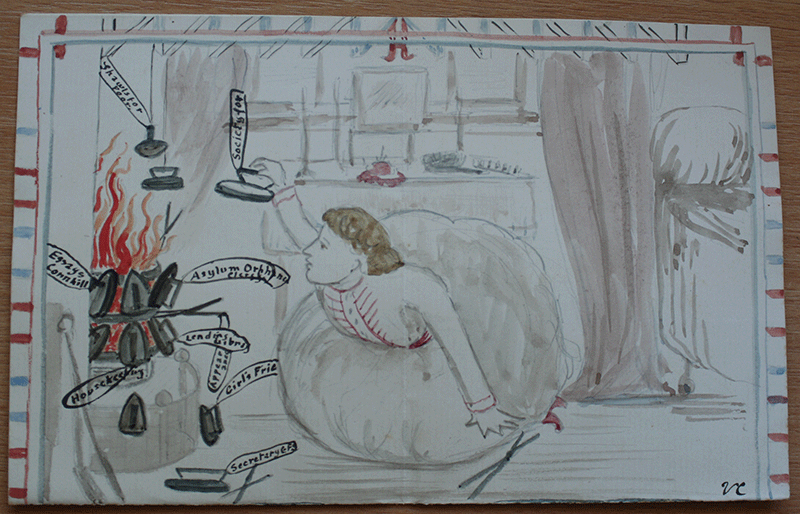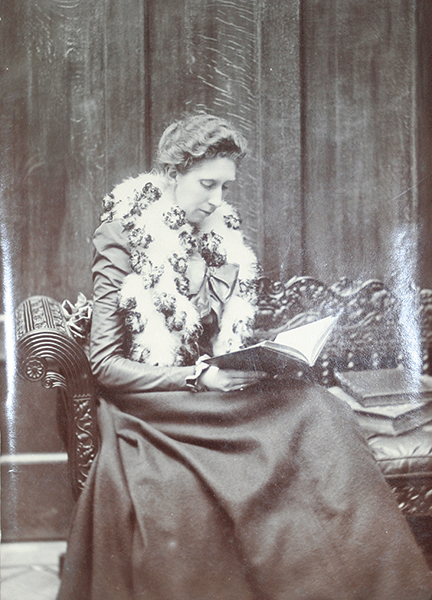 |
Latchkey Home Book Reviews Essays Conference News Featured New Women |
Mary Cholmondeley (1859-1925) By Carolyn W. de la L. Oulton. Like more than one New Woman author, Mary Cholmondeley was ambivalent about both the phrase itself and its propensity to conflate very different figures of the 1890s. Her comment on the Women Writers Dinner of 1898 is certainly not promising: “What an assembly of ill bred ill dressed slovenly looking women. And these as my confreres with whom I ought to feel “esprit de corps!” (Diary 21 June 1898). But just a year after this event Cholmondeley would become famous as the author of the bestselling novel Red Pottage, probably the only book of 1899 to be praised from the pulpit of St. Paul’s Cathedral while also being sufficiently controversial to be ritually destroyed by one irate reader (who seemingly bought it especially for the purpose and wrote to tell her so) (Bookman).  "Too Many Irons in the Fire, Mary," by Victorian Cholmondeley, 1885. Used by permission of Alison Cholmondeley. The difficulty of managing her household and parish responsibilities alongside the demands of deadlines and editorial revisions often left her exhausted. The day before her thirty-sixth birthday she confided to her diary that she felt unable to endure the life for many more years without being “engulfed in fatigue” (7 June 1895). As she noted ruefully in 1896, “I always find my own county where no one attaches the least value to what I write, has a very wholesome effect on me if I am inclined to be vain, as I always am after living in London” (19 July 1896). Not surprisingly her most celebrated work depicts an increasing sense of tension between country life and literary ambition. In Red Pottage the novelist Hester Gresley rebels against “the preconceived ideas which depute that clergymen’s sisters and daughters should, as a matter of course, offer up their youth and hair and teeth and eyesight on the altar of parochial work” (60); nonetheless she accepts her brother’s verdict that her writing is not real “work,” and almost kills herself by getting up at dawn every morning to complete her novel in peace.
Cholmondeley’s friend and first biographer Percy Lubbock hints at the further barriers created by her social milieu. If the young men of her acquaintance never directly disapproved of her writing, it was on the understanding that “the young woman was welcome to her fancies, but she couldn’t expect to upset the world in order to make room for them” (51-52). Highly class-conscious herself, her abiding memory of meeting the American poet Bret Harte was trying to explain to him that “If a man calls a girl ‘gurl’ and a brougham a ‘brewham,’ I may like and admire him, but I know for all that what society he is not in” (Diary 15 June 1898). As a young writer in the early 1880s, Cholmondeley sought advice from friends including Anne Thackeray Ritchie on how to behave in negotiations with her middle-class publishers, George and Richard Bentley, with whom she would later develop a close and affectionate relationship. Cholmondeley herself recalled that her Shropshire acquaintances were baffled by her desire to join the ranks of “scribblers,” their only term for professional authors of either sex. At one country house party, as she gleefully observed in a letter to Ritchie, “They were a little frightened at first, as they all knew I had perpetrated a book, which of course was odd: but they soon got better, and are now inclined to be curious as to ‘how I did it'” (17 August 1890). [W]hy do I envy people on the road, when all the time I know that the twin hedgerows which keep out “dangerous views” would have choked me, while they protected others[?] It seems I want two opposite things. To be happy, and at ease, and live without effort, to be liked by the majority, to offend none, to attempt nothing. And I want as well to express the thoughts which press upon me… (Diary 17 February 1896) The provincial settings of her first novels, The Danvers Jewels (1887) and Sir Charles Danvers (1889) owe an obvious debt to Eliot. But Cholmondeley’s published work also includes more subversive commentary on women’s status. Stories such as the 1885 “Geoffrey’s Wife,” with its damning indictment of female “innocence” and the parallel lives of protected wives and street prostitutes, still have the power to shock. First published in The Graphic, “Geoffrey’s Wife,” appeared under the misleading initials L. R., a clear enough sign that Cholmondeley had her family’s sensibilities in mind. The 1901 story “The Pitfall”, first published in the Monthly Review, sees a young man reject the woman who has facilitated his fiancée’s seduction by another man, and ultimately marry his fallen lover. By this point there was no question of adopting a pseudonym, but the earlier story is only identifiable as hers because it was later used as a makeweight for a novella, forming part of the volume Moth and Rust together with “Geoffrey’s Wife,” and “The Pitfall” (1902). In 1916 Cholmondeley would return to the charge, reminding readers that if prostitutes “fell” through a love of luxury, this term generally signified the ability to have a bath every day and go outside during daylight hours (“Warp and Woof”). An essay that would hardly have been well received in a rural Shropshire parish. It is hard that women anxious to make an honest livelihood should be stigmatized as hysterical by men when they agitate for a vote. … As far as I know women, almost no woman wishes to support herself. It exhausts her. The fixed hours, the hopelessness of it all crushes her when her first youth is gone. But she has got to do it and I believe this clamour for a vote would die down if men would offer more professions to them, would treat them with greater justice than they have so far accorded them, and would treat the desire to be self supporting with the respect it deserves. (14 March [1911]) During the First World War Cholmondeley’s own work would include bringing hope to the families of missing men whose regiments had been involved in disasters (often caused by official ineptitude). These guarded reports deliberately obfuscated the circumstances in which the men had been lost and were reproduced and sent out in a standard format that might well be the only news to reach their mothers or wives. While she would never write another novel, she did revisit her Victorian past in the family memoir Under One Roof, in 1918.
1 This is the last letter I have been able to locate. Works Cited and Consulted “The Reader. Mary Cholmondeley.” Bookman 41, vol. 18, no. 41, May 1900, pp 40-47. Brown, [Albert] Curtis. “Bargaining with Writers.” Harper’s Magazine, vol. 171, Jun. 1935/Nov. 1935, pp. 26 -35. Cholmondeley, Victoria. Too Many Irons in the Fire, Mary. 1885. Private archive. Cholmondeley, Mary. Diary 1895-1911. Private archive. |
